Bigger, stronger arms are usually high on the list of priorities for some lifters, even if they half-whisper it for fear of being labeled “a bodybuilder,” as if there’s anything wrong with training specifically to add muscle. While there are countless varieties of curls to work the biceps with different angles or equipment, most lifters … Read more
The post How to Do the Hammer Curl for Bigger Biceps and Forearms appeared first on Breaking Muscle.
Bigger, stronger arms are usually high on the list of priorities for some lifters, even if they half-whisper it for fear of being labeled “a bodybuilder,” as if there’s anything wrong with training specifically to add muscle.
While there are countless varieties of curls to work the biceps with different angles or equipment, most lifters overlook how simply holding a dumbbell differently can affect muscle recruitment and overall growth.
The hammer curl uses a simple thumbs-up position to more directly work the forearm muscles and emphasize a different part of the biceps, leading to more growth, bigger arms, and a stronger grip. Here’s why this fundamental dumbbell curl shouldn’t be overlooked.
- How to Do the Hammer Curl
- Hammer Curl Mistakes to Avoid
- Benefits of the Hammer Curl
- Muscles Worked by the Hammer Curl
- Who Should Do the Hammer Curl
- How to Program the Hammer Curl
- Hammer Curl Variations
- Hammer Curl Alternatives
- Frequently Asked Questions
How to Do the Hammer Curl
There’s a good chance that anyone who’s picked up a pair of dumbbells has performed a hammer curl, or something that was supposed to be a hammer curl. It’s an instinctive movement that can be made even more effective when following some simple technique guidelines.
Step 1 — Grab Dumbbells Correctly
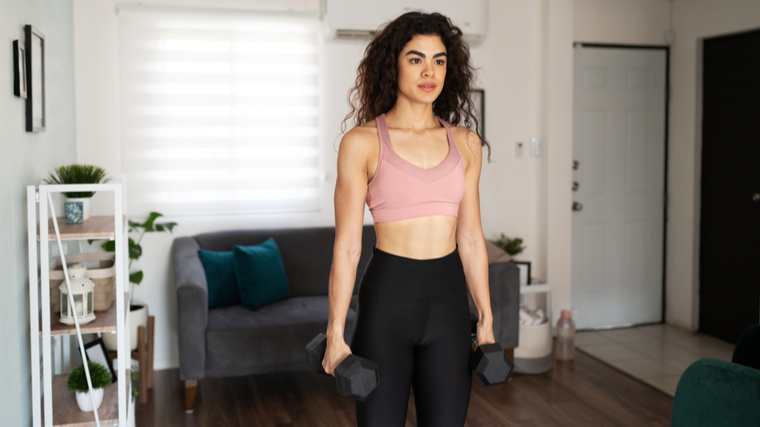
Begin standing with a pair of dumbbells at your sides with your palms facing your body and your thumbs pointing forward. Rather than gripping directly in the center of the handle, slightly offset your grip to have your pinky near the lower weight plate. This requires greater grip and forearm recruitment during the exercise. (You can center your hand on the handle if you prefer.) Flex your triceps to ensure a straight arm and fully locked out starting position.
Form Tip: The offset grip slightly shifts the dumbbell’s center of gravity forward and requires you to squeeze harder during each rep to maintain control of the weight. Gripping with a standard, perfectly centered grip requires less gripping strength. Offsetting your grip to have your thumb touching the top weight requires even less grip strength. Experiment with each slight variation as a way of adjusting the exercise’s intensity.
Step 2 — Curl the Dumbbells to Your Shoulders
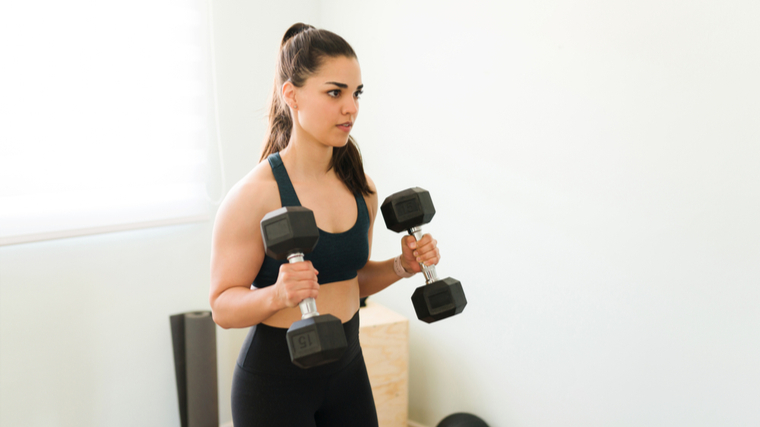
Bend your knees slightly, pull your shoulder blades back, and flex your abs to ensure an upright posture. Flex your biceps to curl the weight to your front deltoids.
The “hammer curl” gets its name from the visual cue of hammering a nail, so keep your wrists neutral, your palms facing each other, and your fingers in a vertical line throughout the exercise. As the weights approach your shoulders, allow your elbows to come forward slightly, letting the dumbbells touch the front of your shoulders.
Form Tip: With most curls, the elbows should remain pinned to your ribs for optimal tension. However, the hammer curl significantly recruits the long head of the biceps, which also plays a role in moving the upper arm at the shoulder. Allowing the elbows to come forward, slightly, by moving at the shoulder lets the long head contract even more strongly. (1) Don’t allow the shoulder movement to become a wild swing. Use a controlled motion.
Step 3 — Lower to Full Extension
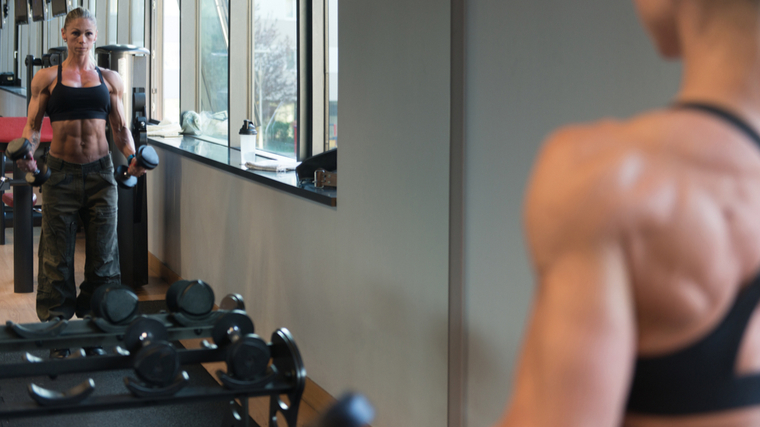
Once the weights touch your shoulders, reverse direction. Keep your hands pointed in the same direction, with your palms facing each other and your fingers stacked vertically. Lower the weights under control until your arms are fully extended in the starting position.
Form Tip: Resetting at the bottom of each rep and achieving a full stretch by contracting the triceps may seem like “resting” the biceps, but it allows a maximum range of motion which contributes to overall growth. It also helps to prevent cheating by making it more difficult to swing the weights into a curled position.
Hammer Curl Mistakes to Avoid
The hammer curl may seem like a simple movement, which it certainly is, but that means there’s even less reason to cheat and less room for error. Here are the most common technique errors.
Rotating Your Hands
A “hammer curl” with your hands positioned any way other than thumbs-up is no longer a hammer curl. Changing your hand and wrist position isn’t necessarily wrong, it’s just a different exercise emphasizing different muscles.

It’s like performing a barbell flat bench press, but gripping the bar with your hands nearly touching instead of being slightly outside shoulder-width. It’s still a valid exercise, but it’s now a close-grip bench press which emphasizes the triceps, not a barbell flat bench press which emphasizes the chest.
The same principle applies to hammer curls; it’s meant to be done with your hands vertical and your palms facing each other. A different grip creates a different exercise.
Avoid It: Make sure you’re doing hammer curls, not pronated (palms down) curls, supinated (palms up) curls, or an angled grip in-between. Keep the “hammering a nail” visualization on your mind. You wouldn’t, couldn’t, and shouldn’t hammer a nail with an angled swing, so be sure to keep your thumbs up.
Swinging Your Body
One of the most common mistakes with hammer curls is swinging your torso to bring the weights up from the bottom. Not only does this increase strain on the lower back, but it reduces biceps activation by starting the exercise with momentum rather than muscular strength.
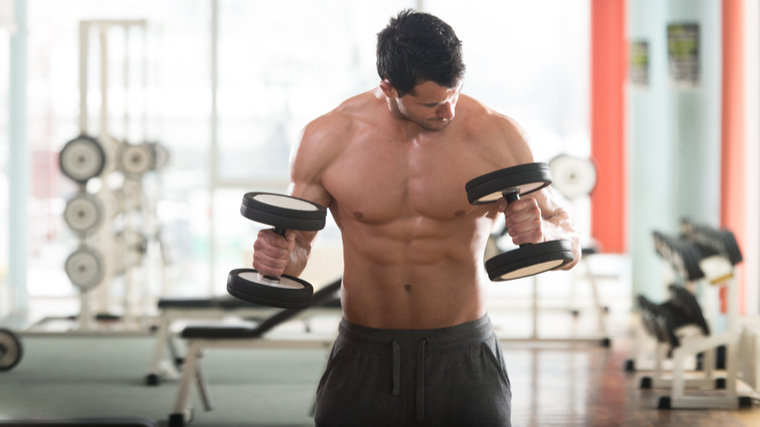
Upper body swinging can sometimes be caused by trying to lift too heavy, but many lifters instinctively swing their body for every rep of every set regardless of the weight, as if it’s the way the exercise “should” be done.
This unconscious movement is an indicator that they’re not treating the hammer curl with the same deliberate intention as they likely do for squats, deadlifts, or other more involved exercises.
Avoid it: Begin each rep from a strict upright posture with your arms at your sides, your abs tense, and your shoulders pulled back. Bracing and contracting your abs while curling can make upper body swinging more noticeable and more preventable. Raising the weights at a slightly slower speed will also discourage swinging.
Benefits of the Hammer Curl
The hammer curl recruits the muscles of the upper arm as well as the lower arm, delivering more overall results than many other curl variations.
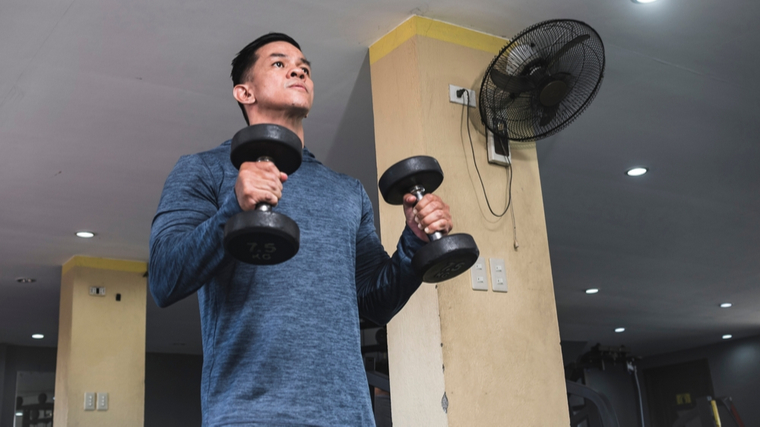
The increased muscle activation and potential for relatively heavier weights make the hammer curl suitable for a wide variety of goals.
Bigger Biceps
Because the biceps are responsible for elbow flexion (curling and bending), the biceps are directly activated during hammer curls. This makes them a key player to adding size to your upper arms.
Bigger Forearms
Few lifters do direct forearm work, but hammer curls are a simple and effective way to build the muscles below the elbow as well as above it. The neutral (thumbs up) hand position increases stress on several muscles of the forearm compared to supinated (palms up) curls.
Increased Grip Strength
Building a stronger grip can not only carryover to improvement in other exercises, it has also been associated with improved overall health. (2) Hammer curls are an efficient way to improve grip strength without needing to add specific grip-building exercises into your general workout program.
Muscles Worked by Hammer Curl
Curls are to bigger biceps what coffee is to mornings — simply necessary. The hammer curl, however, works more than just the biceps.
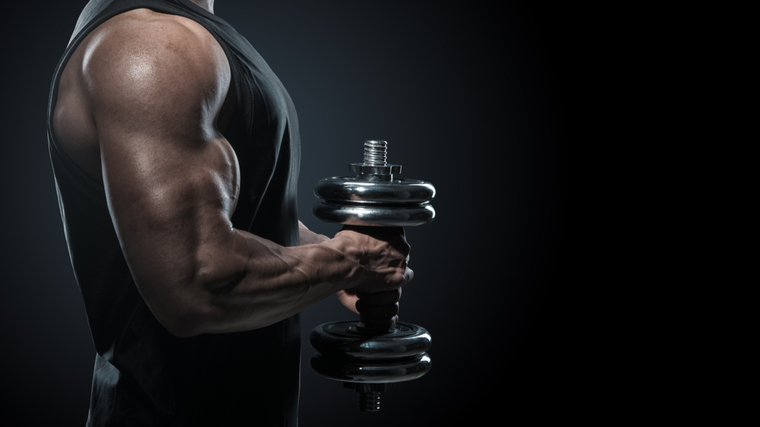
The specific hand position recruits a variety of muscles in the upper and lower arm, making it an important addition to an arm workout.
Biceps Brachii
The biceps brachii is “the biceps muscle” on the front of the upper arm. It’s composed of two separate heads, the long head on the outer part of the biceps and the short head found running along the inner part of the biceps.
Both heads are connected to the elbow, with the short head attaching to the upper arm bone and the long head attaching to the shoulder blade just behind the shoulder joint. Because of this, both parts of the biceps are involved in flexing or bending the elbow, and the long head is also activated when raising the arm at the shoulder. Both heads are also strongly activated when rotating the wrist palm up and palm down (supination and pronation).
Brachialis
The brachialis is considered a “hidden” muscle because it’s not often visible and is located beneath biceps brachii, near the elbow. When the brachialis increases in size, it can essentially “push” the biceps higher, contributing to a larger arm size overall.
Its primary function is to flex and bend the elbow and it is not involved in supination or pronation. For this reason, a neutral-grip (palms facing each other) puts the brachialis in a strong mechanical position. (3) This is also why you can typically use more weight with any neutral-grip curling, rowing, or pulling compared to a pronated or supinated grip.
Brachioradialis
The brachioradialis runs along the thumb-side of the forearm, contributing significant muscle size particularly near the elbow. It stabilizes the forearm during arm movement and directly acts as an elbow flexor.
Forearms
The wrist flexors make up the bulk of the lower arm on the palm-side of the forearm, while the wrist extensors are found on the top side of the forearm. Both muscles are heavily involved in any grip-intensive exercise, like the hammer curl. The wrist flexors work actively to hold the weight in place while the wrist flexors provide stability.
Who Should Do the Hammer Curl
The hammer curl isn’t just used for increasing arm size. It certainly does play a big role in arm training, but it also carries over to help other lifts, making it useful for strength-focused lifters as well as those prioritizing muscle size.
Lifters Training for More Muscle
The hammer curl will help to pack size onto your arms, including the often neglected forearms. While some lifters may be reluctant to include direct arm training in their workout due to time or efficiency concerns, the hammer curl is an excellent choice to reap maximum size benefits from just one exercise.
Lifters Training for Strength
Stronger arms and a stronger grip can carry over to any exercise that puts weight in your hands. Having a more secure grip on the bar, regardless of the specific exercise, can help to improve bar control and stability. A stronger grip also directly benefits all types of pulling exercises, from deadlifts and pull-ups to barbell or dumbbell rows.
How to Program the Hammer Curl
Just because it’s an “arm curl” doesn’t mean the hammer curl should be treated with light weights and high reps. Here’s how to fit hammer curls into your plan for better results.
Heavy Weight, Low to Moderate Reps
Because the hammer curl uses a neutral-grip, the arms are put into a significantly stronger pulling position than if the hands were palm-up. This lets you move heavier weights without sacrificing technique. Four to five sets of six to eight reps turns the hammer curl into a serious strength-builder without needing to swing the weights around.
Moderate Weight, Moderate Reps
Training hammer curls with a classic bodybuilding-style approach using three to four sets of 8 to 12 reps is a reliable way to build arm size with this fundamental exercise. This type of workout should deliver an excellent pump in the forearms and biceps.
Hammer Curl Variations
The hammer curl is primarily unique for its specifically neutral hand position. There are several simple and effective variations of the basic hammer curl to fine-tune the results to your specific needs.
Single-Arm Hammer Curl
Training unilaterally (one side at a time) allows you to use a slightly heavier weight in either hand compared to lifting both sides together. (4) Training each side separately also allows you to more specifically address natural strength discrepancies, since one side of the body is typically stronger than the other.
Another significant benefit of the single-arm hammer curl is stricter technique. Specifically, by bracing the non-working arm on the back of a bench, upright post, or stable object, you can create more stability and ensure that you don’t use any upper-body momentum.
Cable Rope Hammer Curl
Curling using a cable provides constant tension and increases the overall muscle-building stimulus. The rope attachment allows you to use a neutral-grip, compared to straight-bar attachments.
Cable hammer curls also make it more difficult to cheat with your torso because the cable disperses much of the momentum that would be moving the weight and keeps stress on the target muscles.
Pinwheel Curl
The pinwheel curl, sometimes called the cross-body curl, changes the range of motion by sliding the weight across the body rather than remaining extended in front. This slightly shortened range of motion changes the stress on the muscles, recruiting the brachialis and further emphasizing the long head of the biceps.
Because the weight is closer to your body’s center of gravity, a heavier weight can be used compared to standard hammer curls. Pinwheel curls are typically done one arm at a time or alternating arms with each repetition.
Hammer Curl Alternatives
Most lifters can be overwhelmed with curling options. Here are a handful of options to incorporate in addition to, or instead of, the hammer curl.
Supinating Curl
The classic supinating curl involves rotation during the exercise, beginning with the weights facing the body in the bottom and the palms facing up in the top position. This recruits both heads of the biceps brachii more significantly because they work to rotate the forearm.
By focusing on “twisting the pinky up” at the top of the curl, the biceps contract fully. Most lifters are surprised by the intense muscle activation from this simple technique adjustment.
Reverse Dumbbell Curl
Reverse dumbbell curls use a palms-down grip throughout the exercise. This de-emphasizes the biceps brachii and puts increased muscular stress on the brachioradialis, brachialis, and wrist extensors.
This overlooked exercise is an excellent choice for prioritizing lower arm size and strength, because the biceps are not significantly activated.
Incline Curl
The incline curl is a bodybuilding staple. Using a high-angle incline bench allows the arms to stretch behind the torso in the bottom position, which significantly activates the long head of the biceps.
Incline curls also encourage strict form, due to the stretch in the bottom position as well as the fully supported seat back which helps to prevent swinging. Be sure not to lean forward, which reduces the incline and defeats the purpose of the exercise. Keep your head and shoulders in contact with the pad.
FAQs
How many different curls should I do in each workout?
Programming direct arm training, like curls, into a workout plan means walking a fine line between efficiency and effectiveness. Few lifters need to dedicate a huge chunk of time (multiple exercises on multiple days per week) to training arms. However, the other extreme (zero direct arm training) can compromise results and eventually lead to arms that do require a significant amount of attention.
Generally speaking, if your goal is to build larger arms, incorporating one or two different exercises two to three days per week should be sufficient, depending on your overall training split and the specific sets and reps. If your goal is primarily strength, not size, directly training biceps with one or two exercises once or twice per week can be an effective and efficient plan.
Why does my elbow hurt during the exercise?
If hammer curls aggravate pre-existing elbow pain, you’re likely not keeping your wrists in a neutral position during the curl. By rotating the wrist palm up or palm down, you may be increasing strain on the tendons and supportive tissues of the elbow.
Reduce the weight and focus on maintaining a vertically stacked hand when raising and lowering the weight. Lifting with a slower tempo can also help to dial in perfect technique.
Pick Up The Hammer Curls
To paraphrase an old saying, “Whosoever performs hammer curls, if they be consistent, shall possess bigger and stronger arms.” It’s a useful lift for physique-focused lifters as well as performance-based lifters, and is an ideal choice for blending size and strength into a single arm exercise.
References
- Chalmers PN, Cip J, Trombley R, et al. Glenohumeral Function of the Long Head of the Biceps Muscle: An Electromyographic Analysis. Orthop J Sports Med. 2014;2(2):2325967114523902. Published 2014 Feb 26. doi:10.1177/2325967114523902
- Bohannon RW. Grip Strength: An Indispensable Biomarker For Older Adults. Clin Interv Aging. 2019;14:1681-1691. Published 2019 Oct 1. doi:10.2147/CIA.S194543
- Plantz MA, Bordoni B. Anatomy, Shoulder and Upper Limb, Brachialis Muscle. [Updated 2022 Feb 22]. In: StatPearls [Internet]. Treasure Island (FL): StatPearls Publishing; 2022 Jan-. Available from: https://www.ncbi.nlm.nih.gov/books/NBK551630/
- Costa E, Moreira A, Cavalcanti B, Krinski K, Aoki M. Effect of unilateral and bilateral resistance exercise on maximal voluntary strength, total volume of load lifted, and perceptual and metabolic responses. Biol Sport. 2015;32(1):35-40. doi:10.5604/20831862.1126326
Featured Image: MDV Edwards
The post How to Do the Hammer Curl for Bigger Biceps and Forearms appeared first on Breaking Muscle.






